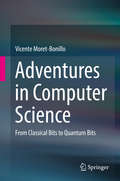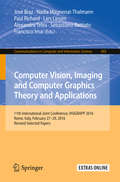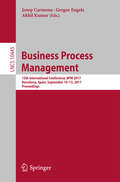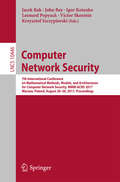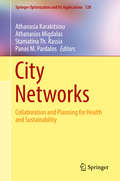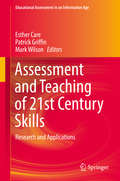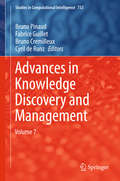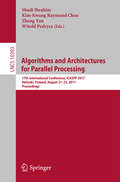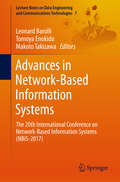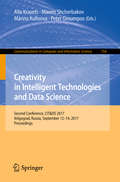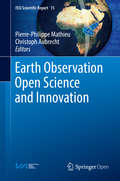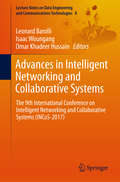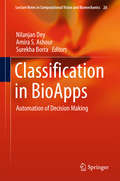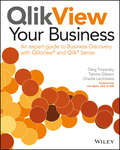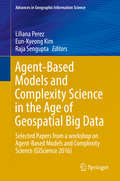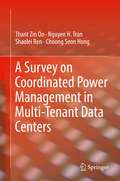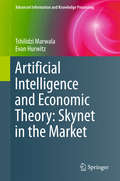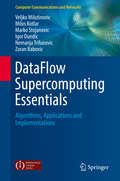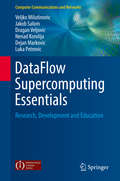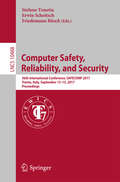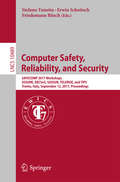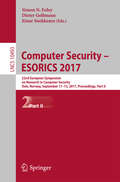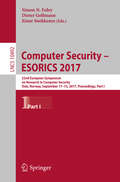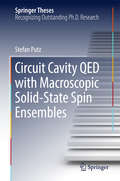- Table View
- List View
Adventures in Computer Science: From Classical Bits to Quantum Bits
by Vicente Moret-BonilloThe main focus of this textbook is the basic unit of information and the way in which our understanding of this has evolved over time. In particular the author covers concepts related to information, classical computing, logic, reversible computing, quantum mechanics, quantum computing, thermodynamics and some artificial intelligence and biology, all approached from the viewpoint of computer sciences. The book begins by asking the following nontrivial question: what is a bit? The author then discusses logic, logic gates, reversible computing and reversible architectures, and the concept of disorder. He then tries to establish the relationship between three essential questions that justify quantum approaches in computer sciences: the energy required to perform a real-life computation, the size of current processors, and the reversibility of quantum operations. Based on these concepts, the author establishes the conditions that justify the use of quantum techniques for certain kinds of computational tasks, and he uses formal descriptions and formal argumentations to introduce key quantum mechanical concepts and approaches. The rest of the book is formally different, focusing on practical issues, including a discussion of remarkable quantum algorithms in a treatment based on quantum circuit theory. The book is valuable for graduate students in computer science, and students of other disciplines who are engaged with physical models of information and computing.
Computer Vision, Imaging and Computer Graphics Theory and Applications: 11th International Joint Conference, VISIGRAPP 2016, Rome, Italy, February 27 – 29, 2016, Revised Selected Papers (Communications in Computer and Information Science #693)
by Nadia Magnenat-Thalmann Sebastiano Battiato José Braz Lars Linsen Paul Richard Francisco Imai Alexandru TeleaThis book constitutes the refereed proceedings of the International Conference, VISIGRAPP 2010, the Joint Conference on Computer Vision Theory and Applications (VISAPP), on Imaging Theory and Applications (IMAGAPP), and on Computer Graphics Theory and Applications (GRAPP), held in Angers, France, in May 2010. The 19 revised full papers presented together with two invited papers were carefully reviewed and selected. The papers are organized in topical sections on computer vision theory and applications; imaging theory and applications; computer graphics theory and applications; and information visualization theory and applications.
Business Process Management: 15th International Conference, Bpm 2017, Barcelona, Spain, September 10-15, 2017, Proceedings (Lecture Notes in Computer Science #10445)
by Gregor Engels Josep Carmona Akhil KumarThis book constitutes the proceedings of the BPM Forum from the International Conference on Business Process Management, BPM 2017, held in Barcelona, Spain, September 2017. The BPM Forum hosts innovative research which has a high potential of stimulating discussions. The papers selected for the forum are expected to showcase fresh ideas from exciting and emerging topics in BPM, even if they are not yet as mature as the regular papers at the conference. The volume contains 11 full papers carefully reviewed and selected from 97 submissions. Each paper was reviewed by a team comprising of a senior PC and four regular PC members who engage in a discussion phase after the initial reviews were prepared. The authors eventually receive four review reports, and a meta-review that summarizes the reviews and the discussion. The selected papers cover topics related to process models and metrics, mining and compliance, and to other innovative ideas such as gamification, smart devices and digital innovation as far as they pertain to BPM.
Computer Network Security: 7th International Conference on Mathematical Methods, Models, and Architectures for Computer Network Security, MMM-ACNS 2017, Warsaw, Poland, August 28-30, 2017, Proceedings (Lecture Notes in Computer Science #10446)
by Krzysztof Szczypiorski Jacek Rak John Bay Igor Kotenko Leonard Popyack Victor SkorminThis book presents the refereed proceedings of the International Workshop on Mathematical Methods, Models, and Architectures for Network Security Systems, MMM-ACNS 2001, held in St. Petersburg in May 2001. The 24 revised full papers presented together with five invited contributions were carefully reviewed and selected from 36 submissions. The papers are organized in topical sections on network security systems: foundations, models and architectures; intrusion detection: foundations and models; access control, authentication, and authorization; and cryptography and steganography: mathematical basis, protocols, and applied methods.
Creating with Mobile Media
by Marsha BerryThis book investigates the convergence between locative, mobile and social media in order to show how people use mobile media for their creative practice--creative writing, photography, video and filmmaking. The central thematic focus of this book explores how mobile media has created new opportunities and contexts for creative practitioners. It draws together creative practice research with non-representational theory and digital ethnography to provide a fresh perspective on the place mobile media has in our everyday creative lives. Fictionalized and semi-fictional vignettes are used to present empirical material taken from fieldnotes and interviews to demonstrate how new forms and genres of art making have arisen because of the affordances of mobile media. The chapters in this volume have been arranged into a sequence according to the kinds of actions that make up various creative practices.
City Networks: Collaboration and Planning for Health and Sustainability (Springer Optimization and Its Applications #128)
by Panos M. Pardalos Stamatina Th. Rassia Athanasia Karakitsiou Athanasios MigdalasThis book both analyzes and synthesizes new cutting-edge theories and methods for future design implementations in smart cities through interdisciplinary synergizing of architecture, technology, and the Internet of Things (IoT). Implementation of IoT enables the collection and data exchange of objects embedded with electronics, software, sensors, and network connectivity. Recently IoT practices have moved into uniquely identifiable objects that are able to transfer data directly into networks. This book features new technologically advanced ideas, highlighting properties of smart future city networks. Chapter contributors include theorists, computer scientists, mathematicians, and interdisciplinary planners, who currently work on identifying theories, essential elements, and practices where the IoT can impact the formation of smart cities and sustainability via optimization, network analyses, data mining, mathematical modeling and engineering. Moreover, this book includes research-based theories and real world practices aimed toward graduate researchers, experts, practitioners and the general public interested in architecture, engineering, mathematical modeling, industrial design, computer science technologies, and related fields.
Assessment and Teaching of 21st Century Skills: Research and Applications (Educational Assessment in an Information Age)
by Mark Wilson Patrick Griffin Esther CareRapid--and seemingly accelerating--changes in the economies of developed nations are having a proportional effect on the skill sets required of workers in many new jobs. Work environments are often technology-heavy, while problems are frequently ill-defined and tackled by multidisciplinary teams. This book contains insights based on research conducted as part of a major international project supported by Cisco, Intel and Microsoft. It faces these new working environments head-on, delineating new ways of thinking about '21st-century' skills and including operational definitions of those skills. The authors focus too on fresh approaches to educational assessment, and present methodological and technological solutions to the barriers that hinder ICT-based assessments of these skills, whether in large-scale surveys or classrooms. Equally committed to defining its terms and providing practical solutions, and including international perspectives and comparative evaluations of assessment methodology and policy, this volume tackles an issue at the top of most educationalists' agendas.
Advances in Knowledge Discovery and Management: Volume 7 (Studies in Computational Intelligence #732)
by Fabrice Guillet Bruno Pinaud Bruno Cremilleux Cyril RunzThis book is a collection of representative and novel works done in Data Mining, Knowledge Discovery, Clustering and Classification that were originally presented in French at the EGC'2012 Conference held in Bordeaux, France, on January 2012. This conference was the 12th edition of this event, which takes place each year and which is now successful and well-known in the French-speaking community. This community was structured in 2003 by the foundation of the French-speaking EGC society (EGC in French stands for ``Extraction et Gestion des Connaissances'' and means ``Knowledge Discovery and Management'', or KDM). This book is intended to be read by all researchers interested in these fields, including PhD or MSc students, and researchers from public or private laboratories. It concerns both theoretical and practical aspects of KDM. The book is structured in two parts called ``Knowledge Discovery and Data Mining'' and ``Classification and Feature Extraction or Selection''. The first part (6 chapters) deals with data clustering and data mining. The three remaining chapters of the second part are related to classification and feature extraction or feature selection.
Algorithms and Architectures for Parallel Processing: 17th International Conference, ICA3PP 2017, Helsinki, Finland, August 21-23, 2017, Proceedings (Lecture Notes in Computer Science #10393)
by Witold Pedrycz Kim-Kwang Raymond Choo Zheng Yan Shadi IbrahimThis book constitutes the proceedings of the 17th International Conference on Algorithms and Architectures for Parallel Processing, ICA3PP 2017, held in Helsinki, Finland, in August 2017. The 25 full papers presented were carefully reviewed and selected from 117 submissions. They cover topics such as parallel and distributed architectures; software systems and programming models; distributed and network-based computing; big data and its applications; parallel and distributed algorithms; applications of parallel and distributed computing; service dependability and security in distributed and parallel systems; service dependability and security in distributed and parallel systems; performance modeling and evaluation. This volume also includes 41 papers of four workshops, namely: the 4th International Workshop on Data, Text, Web, and Social Network Mining (DTWSM 2017), the 5th International Workshop on Parallelism in Bioinformatics (PBio 2017) , the First International Workshop on Distributed Autonomous Computing in Smart City (DACSC 2017), and the Second International Workshop on Ultrascale Computing for Early Researchers (UCER 2017).
Advances in Network-Based Information Systems: The 20th International Conference on Network-Based Information Systems (NBiS-2017) (Lecture Notes on Data Engineering and Communications Technologies #7)
by Makoto Takizawa Leonard Barolli Tomoya EnokidoThis book highlights the latest research findings, innovative research results, methods and development techniques from both theoretical and practical perspectives related to the emerging areas of information networking and their applications. It includes the Proceedings of the 20th International Conference on Network-Based Information Systems (NBiS-2017), held on August 24-26, 2017 in Toronto, Canada. Today's networks and information systems are evolving rapidly. Further, there are dynamic new trends and applications in information networking such as wireless sensor networks, ad hoc networks, peer-to-peer systems, vehicular networks, opportunistic networks, grid and c loud computing, pervasive and ubiquitous computing, multimedia systems, security, multi-agent systems, high-speed networks, and web-based systems. These networks are expected to manage the increasing number of users, provide support for a range of services, guarantee the quality of service (QoS), and optimize their network resources. In turn, these demands are the source of various research issues and challenges that have to be overcome - and which these Proceeding address.
Creativity in Intelligent Technologies and Data Science: Second Conference, CIT&DS 2017, Volgograd, Russia, September 12-14, 2017, Proceedings (Communications in Computer and Information Science #754)
by Alla Kravets Maxim Shcherbakov Marina Kultsova Peter GroumposThis book constitutes the refereed proceedings of the First Conference on Creativity in Intelligent Technologies and Data Science, CIT&DS 2015, held in Volgograd, Russia, in September 2015. The 66 revised full papers and two short papers presented were carefully reviewed and selected from 208 submissions. The papers are organized in topical sections on computational creativity for science and design; knowledge discovery in patent and open sources for creative tasks; software computer-aided design and agent-based systems; conceptual, cognitive and qualitative modeling with application in intelligent decision making; design creativity in CAD/CAM/CAE/PDM; intelligent decision support for continual improvement process; data science in energy management, transportation and urban development; data science in social networks analysis; natural language and image processing and analysis; game-based learning technologies in engineering education and educational games design; personalized learning in Web-based intelligent educational systems; e-inclusion: development of smart mobile applications for people with disabilities.
Earth Observation Open Science and Innovation (ISSI Scientific Report Series #15)
by Pierre-Philippe Mathieu Christoph AubrechtThis book is published open access under a CC BY 4. 0 license. Over the past decades, rapid developments in digital and sensing technologies, such as the Cloud, Web and Internet of Things, have dramatically changed the way we live and work. The digital transformation is revolutionizing our ability to monitor our planet and transforming the way we access, process and exploit Earth Observation data from satellites. This book reviews these megatrends and their implications for the Earth Observation community as well as the wider data economy. It provides insight into new paradigms of Open Science and Innovation applied to space data, which are characterized by openness, access to large volume of complex data, wide availability of new community tools, new techniques for big data analytics such as Artificial Intelligence, unprecedented level of computing power, and new types of collaboration among researchers, innovators, entrepreneurs and citizen scientists. In addition, this book aims to provide readers with some reflections on the future of Earth Observation, highlighting through a series of use cases not just the new opportunities created by the New Space revolution, but also the new challenges that must be addressed in order to make the most of the large volume of complex and diverse data delivered by the new generation of satellites.
Advances in Intelligent Networking and Collaborative Systems: The 9th International Conference on Intelligent Networking and Collaborative Systems (INCoS-2017) (Lecture Notes on Data Engineering and Communications Technologies #8)
by Isaac Woungang Leonard Barolli Omar Khadeer HussainThe aim of this book is to provide the latest research findings, innovative research results, methods and development techniques from both theoretical and practical perspectives related to intelligent social networks and collaborative systems, intelligent networking systems, mobile collaborative systems, secure intelligent cloud systems, etc. , and to reveal synergies among various paradigms in the multi-disciplinary field of intelligent collaborative systems. It presents the Proceedings of the 9th International Conference on Intelligent Networking and Collaborative Systems (INCoS-2017), held on August 24-26, 2017 in Toronto, Canada. With the rapid evolution of the Inte rnet, we are currently experiencing a shift from the traditional sharing of information and applications as the main purpose of the Web to an emergent paradigm that puts people at the very centre of networks and exploits the value of people's connections, relations and collaborations. Social networks are also playing a major role in the dynamics and structure of intelligent Web-based networking and collaborative systems. Virtual campuses, virtual communities and organi zations effectively leverage intelligent networking and collaborative systems by tapping into a broad range of formal and informal electronic relations, such as business-to-business, peer-to-peer and many types of online collaborative learning interactions, including the emerging e-learning systems. This has resulted in entangled systems that need to be managed efficiently and autonomously. In addition, the latest and powerful technologies based on Grid and wireless infrastructure as well as Cloud computing are now greatly enhancing collaborative and networking applications, but are also facing new issues and challenges. The principal objective of the research and development community is to stimulate research that leads to the creation of responsive environments for networking and, in the longer-term, the development of adaptive, secure, mobile, and intuitive intelligent systems for collaborative work and learning.
Classification in BioApps: Automation of Decision Making (Lecture Notes in Computational Vision and Biomechanics #26)
by Nilanjan Dey Amira S. Ashour Surekha BorraThis book on classification in biomedical image applications presents original and valuable research work on advances in this field, which covers the taxonomy of both supervised and unsupervised models, standards, algorithms, applications and challenges. Further, the book highlights recent scientific research on artificial neural networks in biomedical applications, addressing the fundamentals of artificial neural networks, support vector machines and other advanced classifiers, as well as their design and optimization. In addition to exploring recent endeavours in the multidisciplinary domain of sensors, the book introduces readers to basic definitions and features, signal filters and processing, biomedical sensors and automation of biomeasurement systems. The target audience includes researchers and students at engineering and medical schools, researchers and engineers in the biomedical industry, medical doctors and healthcare professionals.
QlikView Your Business: An Expert Guide To Business Discovery With Qlikview And Qlik Sense
by Oleg Troyansky Charlie Leichtweis Tammy Gibson Lars Bjorkcomplex data points. Many visualization tools are complex and require advanced training, but QlikView's toolset was specifically designed for speed and ease of use. This book gets you up and running quickly, using QlikView and Qlik Sense to deliver timely and relevant results.Develop solutions to analyze sales, profitability, and inventoryUnderstand the business scenarios relevant to each solutionUnderstand best practices for data modelingLearn advanced techniques in data aggregation and chart developmentThis book goes beyond the basics to illustrate little-known features and techniques for getting the most out of the toolset, supporting the needs of the business analysts who use it, as well as the developers who support it. QlikView Your Business is your essential guide to better data analysis.
Agent-Based Models and Complexity Science in the Age of Geospatial Big Data: Selected Papers from a workshop on Agent-Based Models and Complexity Science (GIScience 2016) (Advances in Geographic Information Science)
by Liliana Perez Eun-Kyeong Kim Raja SenguptaThis book contains a selection of papers presented during a special workshop on Complexity Science organized as part of the 9th International Conference on GIScience 2016. Expert researchers in the areas of Agent-Based Modeling, Complexity Theory, Network Theory, Big Data, and emerging methods of Analysis and Visualization for new types of data explore novel complexity science approaches to dynamic geographic phenomena and their applications, addressing challenges and enriching research methodologies in geography in a Big Data Era.
A Survey on Coordinated Power Management in Multi-Tenant Data Centers
by Thant Zin Oo Nguyen H. Tran Shaolei Ren Choong Seon HongThis book investigates the coordinated power management of multi-tenant data centers that account for a large portion of the data center industry. The authors include discussion of their quick growth and their electricity consumption, which has huge economic and environmental impacts. This book covers the various coordinated management solutions in the existing literature focusing on efficiency, sustainability, and demand response aspects. First, the authors provide a background on the multi-tenant data center covering the stake holders, components, power infrastructure, and energy usage. Then, each power management mechanism is described in terms of motivation, problem formulation, challenges and solution.
Artificial Intelligence and Economic Theory: Skynet in the Market (Advanced Information and Knowledge Processing)
by Tshilidzi Marwala Evan HurwitzThis book theoretically and practically updates major economic ideas such as demand and supply, rational choice and expectations, bounded rationality, behavioral economics, information asymmetry, pricing, efficient market hypothesis, game theory, mechanism design, portfolio theory, causality and financial engineering in the age of significant advances in man-machine systems. The advent of artificial intelligence has changed many disciplines such as engineering, social science and economics. Artificial intelligence is a computational technique which is inspired by natural intelligence concepts such as the swarming of birds, the working of the brain and the pathfinding of the ants. Artificial Intelligence and Economic Theory: Skynet in the Market analyses the impact of artificial intelligence on economic theories, a subject that has not been studied. It also introduces new economic theories and these are rational counterfactuals and rational opportunity costs. These ideas are applied to diverse areas such as modelling of the stock market, credit scoring, HIV and interstate conflict. Artificial intelligence ideas used in this book include neural networks, particle swarm optimization, simulated annealing, fuzzy logic and genetic algorithms. It, furthermore, explores ideas in causality including Granger as well as the Pearl causality models.
DataFlow Supercomputing Essentials: Algorithms, Applications and Implementations (Computer Communications and Networks)
by Nemanja Trifunovic Veljko Milutinovic Milos Kotlar Marko Stojanovic Igor Dundic Zoran BabovicThis informative text/reference highlights the potential of DataFlow computing in research requiring high speeds, low power requirements, and high precision, while also benefiting from a reduction in the size of the equipment. The cutting-edge research and implementation case studies provided in this book will help the reader to develop their practical understanding of the advantages and unique features of this methodology. This work serves as a companion title to DataFlow Supercomputing Essentials: Algorithms, Applications and Implementations, which reviews the key algorithms in this area, and provides useful examples. Topics and features: reviews the library of tools, applications, and source code available to support DataFlow programming; discusses the enhancements to DataFlow computing yielded by small hardware changes, different compilation techniques, debugging, and optimizing tools; examines when a DataFlow architecture is best applied, and for which types of calculation; describes how converting applications to a DataFlow representation can result in an acceleration in performance, while reducing the power consumption; explains how to implement a DataFlow application on Maxeler hardware architecture, with links to a video tutorial series available online. This enlightening volume will be of great interest to all researchers investigating supercomputing in general, and DataFlow computing in particular. Advanced undergraduate and graduate students involved in courses on Data Mining, Microprocessor Systems, and VLSI Systems, will also find the book to be a helpful reference.
DataFlow Supercomputing Essentials: Research, Development and Education (Computer Communications and Networks)
by Dejan Markovic Jakob Salom Veljko Milutinovic Dragan Veljovic Nenad Korolija Luka PetrovicThis informative text/reference highlights the potential of DataFlow computing in research requiring high speeds, low power requirements, and high precision, while also benefiting from a reduction in the size of the equipment. The cutting-edge research and implementation case studies provided in this book will help the reader to develop their practical understanding of the advantages and unique features of this methodology. This work serves as a companion title to DataFlow Supercomputing Essentials: Algorithms, Applications and Implementations, which reviews the key algorithms in this area, and provides useful examples. Topics and features: reviews the library of tools, applications, and source code available to support DataFlow programming; discusses the enhancements to DataFlow computing yielded by small hardware changes, different compilation techniques, debugging, and optimizing tools; examines when a DataFlow architecture is best applied, and for which types of calculation; describes how converting applications to a DataFlow representation can result in an acceleration in performance, while reducing the power consumption; explains how to implement a DataFlow application on Maxeler hardware architecture, with links to a video tutorial series available online. This enlightening volume will be of great interest to all researchers investigating supercomputing in general, and DataFlow computing in particular. Advanced undergraduate and graduate students involved in courses on Data Mining, Microprocessor Systems, and VLSI Systems, will also find the book to be a helpful reference.
Computer Safety, Reliability, and Security: 36th International Conference, SAFECOMP 2017, Trento, Italy, September 13-15, 2017, Proceedings (Lecture Notes in Computer Science #10488)
by Friedemann Bitsch Erwin Schoitsch Stefano TonettaSAFECOMP '96 contains papers presented at the 15th International Conference on Computer Safety, Reliability and Security held in Vienna, Austria, 23-25 October 1996. The conference aimed to provide an opportunity for technical developers and users to discuss and review their experiences, to consider the best technologies currently available, and to identify the skills and technologies required for the future. SAFECOMP '96 focuses on critical computer applications and is intended as a platform for technology transfer between academia, industry and research institutions. SAFECOMP '96 will be of interest to all those in universities, research institutions, industry and business who want to be well-informed about the current international state of the art in computer safety, reliability and security.
Computer Safety, Reliability, and Security: SAFECOMP 2017 Workshops, ASSURE, DECSoS, SASSUR, TELERISE, and TIPS, Trento, Italy, September 12, 2017, Proceedings (Lecture Notes in Computer Science #10489)
by Friedemann Bitsch Erwin Schoitsch Stefano TonettaSAFECOMP '96 contains papers presented at the 15th International Conference on Computer Safety, Reliability and Security held in Vienna, Austria, 23-25 October 1996. The conference aimed to provide an opportunity for technical developers and users to discuss and review their experiences, to consider the best technologies currently available, and to identify the skills and technologies required for the future. SAFECOMP '96 focuses on critical computer applications and is intended as a platform for technology transfer between academia, industry and research institutions. SAFECOMP '96 will be of interest to all those in universities, research institutions, industry and business who want to be well-informed about the current international state of the art in computer safety, reliability and security.
Computer Security – ESORICS 2017: 22nd European Symposium On Research In Computer Security, Oslo, Norway, September 11-15, 2017, Proceedings, Part I (Lecture Notes in Computer Science #10492)
by Dieter Gollmann Simon N. Foley Einar SnekkenesThe two-volume set, LNCS 10492 and LNCS 10493 constitutes the refereed proceedings of the 22nd European Symposium on Research in Computer Security, ESORICS 2017, held in Oslo, Norway, in September 2017. The 54 revised full papers presented were carefully reviewed and selected from 338 submissions. The papers address issues such as data protection; security protocols; systems; web and network security; privacy; threat modeling and detection; information flow; and security in emerging applications such as cryptocurrencies, the Internet of Things and automotive.
Computer Security – ESORICS 2017: 22nd European Symposium On Research In Computer Security, Oslo, Norway, September 11-15, 2017, Proceedings, Part I (Lecture Notes in Computer Science #10492)
by Dieter Gollmann Simon N. Foley Einar SnekkenesThe two-volume set, LNCS 10492 and LNCS 10493 constitutes the refereed proceedings of the 22nd European Symposium on Research in Computer Security, ESORICS 2017, held in Oslo, Norway, in September 2017. The 54 revised full papers presented were carefully reviewed and selected from 338 submissions. The papers address issues such as data protection; security protocols; systems; web and network security; privacy; threat modeling and detection; information flow; and security in emerging applications such as cryptocurrencies, the Internet of Things and automotive.
Circuit Cavity QED with Macroscopic Solid-State Spin Ensembles (Springer Theses)
by Stefan PutzThis thesis combines quantum electrical engineering with electron spin resonance, with an emphasis on unraveling emerging collective spin phenomena. The presented experiments, with first demonstrations of the cavity protection effect, spectral hole burning and bistability in microwave photonics, cover new ground in the field of hybrid quantum systems. The thesis starts at a basic level, explaining the nature of collective effects in great detail. It develops the concept of Dicke states spin-by-spin, and introduces it to circuit quantum electrodynamics (QED), applying it to a strongly coupled hybrid quantum system studied in a broad regime of several different scenarios. It also provides experimental demonstrations including strong coupling, Rabi oscillations, nonlinear dynamics, the cavity protection effect, spectral hole burning, amplitude bistability and spin echo spectroscopy.
